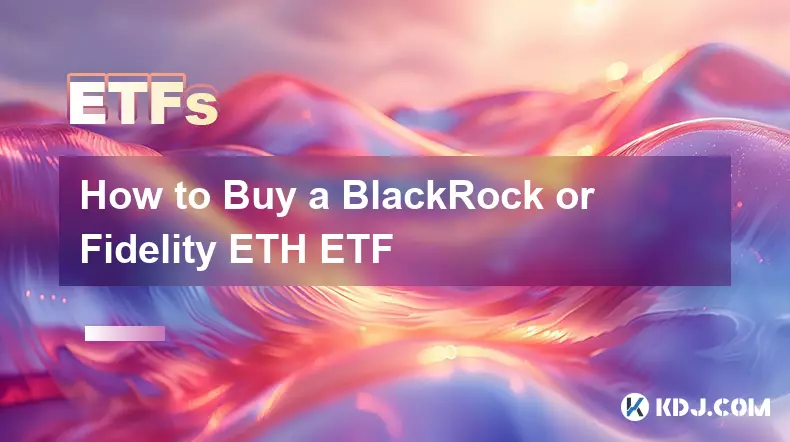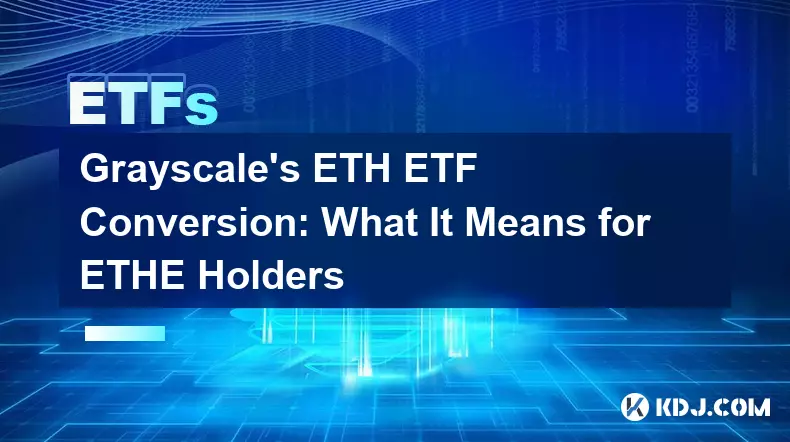-
 bitcoin
bitcoin $107015.826941 USD
-2.18% -
 ethereum
ethereum $3637.352324 USD
-5.18% -
 tether
tether $0.999831 USD
-0.02% -
 xrp
xrp $2.338078 USD
-6.23% -
 bnb
bnb $998.272150 USD
-6.97% -
 solana
solana $167.598257 USD
-10.12% -
 usd-coin
usd-coin $0.999863 USD
0.01% -
 tron
tron $0.282573 USD
-5.09% -
 dogecoin
dogecoin $0.169891 USD
-7.39% -
 cardano
cardano $0.557554 USD
-7.03% -
 hyperliquid
hyperliquid $39.914802 USD
-5.85% -
 chainlink
chainlink $15.414549 USD
-9.97% -
 bitcoin-cash
bitcoin-cash $510.361911 USD
-4.26% -
 ethena-usde
ethena-usde $0.999194 USD
-0.03% -
 stellar
stellar $0.282092 USD
-6.07%
How to Buy a BlackRock or Fidelity ETH ETF
BlackRock and Fidelity's spot Ethereum ETFs offer regulated, accessible exposure to ETH through traditional brokers, simplifying investment but with fees and no direct blockchain access.
Oct 26, 2025 at 03:36 pm

Understanding Ethereum ETFs from BlackRock and Fidelity
1. The launch of spot Ethereum ETFs by major financial institutions like BlackRock and Fidelity marks a pivotal shift in the digital asset landscape. These exchange-traded funds are designed to track the price of Ethereum without requiring investors to directly hold or manage ETH. Instead, they offer exposure through traditional brokerage accounts, making them accessible to a broader audience.
2. Unlike cryptocurrency exchanges where users must handle private keys and wallets, these ETFs operate within regulated financial markets. This means they are subject to SEC oversight and reporting standards, providing a layer of investor protection often missing in decentralized platforms.
3. Each ETF holds actual Ethereum tokens secured by custodial services approved by regulators. This structure differentiates them from futures-based crypto ETFs, which rely on derivatives rather than physical assets.
4. Investors benefit from liquidity, transparency, and integration with existing retirement and taxable investment accounts. The pricing of shares reflects real-time market demand and the underlying net asset value tied to ETH’s performance.
5. It's essential to recognize that while these products simplify access, they come with management fees and may not perfectly mirror Ethereum’s price due to tracking differences and premium/discount fluctuations in secondary trading.
Steps to Purchase Shares in an ETH ETF
1. Open a brokerage account if you don’t already have one. Most major U.S. brokers such as Fidelity, Charles Schwab, E*TRADE, and Robinhood support ETF trading, including newly approved crypto-linked funds.
2. Fund your account using bank transfers, ACH deposits, or other supported methods. Ensure sufficient balance is available for the intended purchase, keeping in mind potential commission fees and share prices.
3. Search for the specific ETF ticker symbol associated with BlackRock’s iShares Ethereum Trust (likely ETHA) or Fidelity’s Ethereum Fund (potentially FETH). Confirm it is a spot ETF backed by actual Ethereum holdings.
4. Place a buy order through the platform’s trading interface. Choose between market orders for immediate execution or limit orders to specify a maximum acceptable price per share.
5. Monitor your portfolio after purchase. Track both the ETF’s performance and its premium or discount relative to the net asset value, which can fluctuate based on investor sentiment and market conditions.
Risks and Considerations for Investors
1. Regulatory uncertainty remains a factor. Although the ETFs are currently approved, future policy changes could impact their structure, taxation, or availability.
2. Market volatility affects both Ethereum’s price and the ETF’s share value. Sudden shifts in crypto markets may lead to sharp movements in ETF valuations, independent of broader stock market trends.
3. Expense ratios vary between providers. BlackRock and Fidelity may charge annual fees ranging from 0.25% to 0.50%, which over time can erode returns, especially in flat or declining markets.
4. Tax treatment differs from direct crypto ownership. Gains from selling ETF shares are typically treated as capital gains, whereas holding actual ETH might involve different reporting obligations depending on jurisdiction.
5. Liquidity and bid-ask spreads can influence trading efficiency. Newer ETFs may experience wider spreads initially, increasing transaction costs for frequent traders or those investing large amounts at once.
Frequently Asked Questions
Can I convert my existing ETH into shares of a BlackRock or Fidelity Ethereum ETF?No direct conversion mechanism exists. You would need to sell your Ethereum on a cryptocurrency exchange, transfer the proceeds to a brokerage account, and then use those funds to purchase ETF shares.
Are dividends paid on Ethereum ETF shares?Ethereum itself does not generate dividend-like income. These ETFs do not distribute earnings because staking rewards, if any, are typically reinvested or used to cover operational costs rather than distributed to shareholders.
Is there a difference between buying an ETH ETF and owning Ethereum directly?Yes. Direct ownership gives full control over private keys and enables participation in network activities like staking or DeFi usage. An ETF offers simplified exposure but no access to the blockchain ecosystem or self-custody benefits.
Will all brokerages offer these Ethereum ETFs immediately upon approval?Not necessarily. While major platforms are expected to list them quickly, smaller or international brokers may delay inclusion due to compliance reviews, infrastructure requirements, or regional regulatory constraints.
Disclaimer:info@kdj.com
The information provided is not trading advice. kdj.com does not assume any responsibility for any investments made based on the information provided in this article. Cryptocurrencies are highly volatile and it is highly recommended that you invest with caution after thorough research!
If you believe that the content used on this website infringes your copyright, please contact us immediately (info@kdj.com) and we will delete it promptly.
- Red Poppy Coin, Australia: A Collector's Guide to the 2025 Release
- 2025-11-04 11:00:15
- Shiba Inu Gets the Nod: Good News for SHIB Holders!
- 2025-11-04 09:35:12
- PI Faces Scrutiny, LINK Gains, BlockDAG Miner Momentum: A Crypto Triad
- 2025-11-04 09:35:12
- Spare Change, Cash, and Bang for Your Buck: A New Yorker's Guide
- 2025-11-04 11:30:01
- Aster, CZ, and $25M: Decoding the DeFi Drama
- 2025-11-04 11:30:01
- Blazpay: The Next Big Crypto Coin Ready to Explode?
- 2025-11-04 09:00:01
Related knowledge

The Complete ETH ETF FAQ: Answering All Your Questions
Nov 04,2025 at 01:54am
What Is an Ethereum ETF and How Does It Work?1. An Ethereum ETF, or Exchange-Traded Fund, is a financial product that tracks the price of Ethereum (ET...

The ETH ETF Explained: How It Works and Why It Matters
Nov 03,2025 at 06:37pm
The Basics of an Ethereum ETF1. An Ethereum ETF, or exchange-traded fund, is a financial product that tracks the price of ether (ETH) without requirin...

Analyzing ETH ETF Inflows: A Key Indicator for Market Sentiment
Nov 01,2025 at 08:19pm
Analyzing ETH ETF Inflows: A Key Indicator for Market SentimentEthereum ETF inflows have emerged as a critical metric in assessing investor confidence...

ETH ETF for Retirement Accounts: Is It a Smart Long-Term Play?
Nov 02,2025 at 08:36am
Why Ethereum ETFs Are Gaining Traction in Retirement Planning1. Institutional interest in Ethereum has surged as digital assets become more integrated...

A Guide to ETH ETF Options Trading: Advanced Strategies Explained
Nov 01,2025 at 10:19pm
Understanding ETH ETF Options and Their Market Mechanics1. Ethereum-based Exchange Traded Funds (ETFs) that offer options trading are financial instru...

Grayscale's ETH ETF Conversion: What It Means for ETHE Holders
Nov 02,2025 at 05:00am
Grayscale's ETH ETF Conversion: A New Chapter for ETHE Investors1. The recent approval of Grayscale’s Ethereum (ETH) ETF marks a pivotal development i...

The Complete ETH ETF FAQ: Answering All Your Questions
Nov 04,2025 at 01:54am
What Is an Ethereum ETF and How Does It Work?1. An Ethereum ETF, or Exchange-Traded Fund, is a financial product that tracks the price of Ethereum (ET...

The ETH ETF Explained: How It Works and Why It Matters
Nov 03,2025 at 06:37pm
The Basics of an Ethereum ETF1. An Ethereum ETF, or exchange-traded fund, is a financial product that tracks the price of ether (ETH) without requirin...

Analyzing ETH ETF Inflows: A Key Indicator for Market Sentiment
Nov 01,2025 at 08:19pm
Analyzing ETH ETF Inflows: A Key Indicator for Market SentimentEthereum ETF inflows have emerged as a critical metric in assessing investor confidence...

ETH ETF for Retirement Accounts: Is It a Smart Long-Term Play?
Nov 02,2025 at 08:36am
Why Ethereum ETFs Are Gaining Traction in Retirement Planning1. Institutional interest in Ethereum has surged as digital assets become more integrated...

A Guide to ETH ETF Options Trading: Advanced Strategies Explained
Nov 01,2025 at 10:19pm
Understanding ETH ETF Options and Their Market Mechanics1. Ethereum-based Exchange Traded Funds (ETFs) that offer options trading are financial instru...

Grayscale's ETH ETF Conversion: What It Means for ETHE Holders
Nov 02,2025 at 05:00am
Grayscale's ETH ETF Conversion: A New Chapter for ETHE Investors1. The recent approval of Grayscale’s Ethereum (ETH) ETF marks a pivotal development i...
See all articles










































































